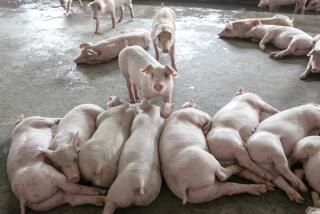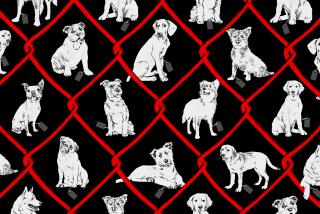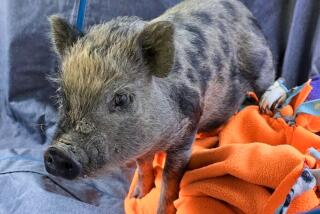Hog Heaven
- Share via
Arnold has a terrible under bite. Bubba has a permanent indentation in the skin over his haunches. Alfred is so fat that his body is virtually spherical, a blimp of fleshiness with a potbelly that drags the ground--when he’s walking that is, which is rare. He prefers to sleep the day away, eyes blissfully closed and lost in the folds of his face, curled up in a doghouse adorned with pig wind chimes.
They have faces and bodies--and sometimes belligerent personalities--that only self-proclaimed “pig lady” Sue Parkinson could love.
These are the rejects of potbellied pigs--animals that have been discarded or abused. Bubba, for example, was tied so tightly with a rope that he was permanently scarred. At a time when it’s trendy to own pigs (actor George Clooney has one) and a movie about a pig (“Babe”) was last year’s box office hit, Parkinson gets daily calls from regretful owners looking to ditch a pig that outgrew its cute piglet stage by a couple hundred pounds.
On five rolling green acres, Parkinson offers one of the few sanctuaries for pet pigs in the state. Lil’ Orphan Hammies, a nonprofit rescue operation that Parkinson founded, now houses about 50 pigs in Solvang and tries to place them with new owners. A smaller refuge in Ojai operating under the Lil’ Orphan Hammies auspices is now filled.
Parkinson eyes a particularly belligerent pig and says, “I treat them like I would a 2-year-old child. I get right in their faces.”
She also gets down in the dust with them to bestow hugs and kisses and occasional low-fat animal cracker treats. Parkinson, who is 41 and married, works as a waitress at night to pay her pigs’ vet and food bills.
People come to her with their pigs and excuses--their pets outgrew their apartments, they’re leaving town and don’t want to take the pig along. Some animals arrive in terrible shape--overweight, sick and sniveling--the result of neglect or inept feeding. (The recommended food is potbellied pig chow.)
Some owners are so upset--or guilt-ridden--they give her a donation of money along with the pig. One well-to-do L.A. pig owner was so grateful that he wrote her a donation for $1,200. Sometimes Parkinson rescues pigs from dire situations--one was confined to a dark storage room in the back of a feed store, another was being fattened up for slaughter. (They’re edible, but unlike pigs raised for slaughter, the amount of meat they provide is paltry.)
“There are certainly not enough sanctuary places,” said the Los Angeles Zoo’s curator of mammals, Michael Dee, who gets at least a phone call a week asking where someone can take an unwanted pig. Lil’ Orphan Hammies is one of the places he has recommended.
“People will buy a potbellied pig and it’s one of those ‘Oh, I’ve got to have this because it’s so cute’ things and they’re usually told, ‘Oh, it won’t get big’ . . . and the next thing they know they’ve got a 155-pound pig running around the house.”
And the zoo is not in the market for pigs.
All the pigs at Lil’ Orphan Hammies are spayed or neutered. The better prospects for adoption are often “fostered” by Rocky More, an L.A.-based partner in the organization.
“The best conditions for a pig are where they can be a pig--where they can run around,” says More, who checks out prospective pig owners to make sure they have enough time and the right temperament. Before the sanctuary lets anyone take a pig, More will instruct the person on how to care for it, train it and shelter it. At the moment, she and her fiance have two meticulously clean pigs living in their Los Angeles home.
One of them, More says, “knows how to open the refrigerator and pull the drawer out with her snout and get lettuce. . . . They really amaze you. At the same time, they’re stubborn and they really do see you as an equal. It doesn’t cower like a dog does.”
No one knows that better than Parkinson. As she wanders among her porcine brood on a sunny morning, she rattles off names and personality quirks. Mandy likes to loll under trees waiting for acorns to drop so she can gobble them up. When Arnold gives a visitor’s lower leg a strong push with his snout, Parkinson says: “He just wants some attention.” Pet his back and a light layer of dust issues up from the black hairy coat.
These pigs are dirty from rooting around in the ground. The mud-wallowing for which pigs are so famous happens usually in hot weather when they are trying to cool their skin. A neighbor comes by and “picks up piggy poop for his garden. It’s great fertilizer.”
The meadow is a maze of little wire fences arrayed with pig houses (“pigloos”), toys and blankets in a tableau that calls to mind a miniature golf course. A radio perched in an oak tree plays Christmas carols into the air. The pigs are free to roam outside the fences and around the cozy one-bedroom house Parkinson shares with her husband, Peter, an auto parts store owner in Solvang. He is good-natured and tolerant of the pigs, if not enthusiastic about his wife’s habit of letting a few spend the night inside the house.
“Ethel! Get outta there!” she yells to one pig rooting--it’s natural for a pig to root--through the purple petunias that adorn the grave site of Parkinson’s beloved personal pet pig, PJ, who died recently. “He’s in a little oak coffin with all his blankets,” she says.
Parkinson, who grew up in Lompoc, was the kid who always had an exotic pet. She raised ferrets, rescued rats from high school biology class, and even smuggled in an iguana that was stranded on a cruise ship. “I found my passion,” she says as she cleans Percy’s ears. “I always took in injured animals.”
She got PJ five years ago--”I bought him at a pet store swap meet,” she says. The seller told her the tiny pig would stay small--a common fallacy perpetuated by some pet store owners and breeders, she says.
PJ, who slept in Parkinson’s house, grew to be 200 pounds. Although full-grown potbellied pigs vary in size, they all eat lustily and store fat with alarming efficiency. Many are over 200 pounds. And many of Parkinson’s pigs are just plain overweight.
“It can take years to get weight off,” Parkinson says. “They don’t really exercise. You’re not really going to lose weight if you just get up, walk out here, eat, lay down, get up and go pee.”
Parkinson, who just recently shed about 50 pounds herself, looks fit in her dirty jeans--which is about the fanciest you can dress around outdoor pigs. Her hands are perpetually dirty.
After she got PJ, her husband bought her several more pigs. “It was my hobby,” she says. When a woman incapacitated by back surgery asked Parkinson if she could take her pig, Parkinson began what grew into her rescue operation.
She says she is unable to have children, but she appears to be contentedly childless. “Babies don’t fit into my life,” she says. “I couldn’t change a diaper.”
Parkinson’s pig avocation has made her a minor celebrity in Solvang--which is already devoted to large-scale eccentricity. After all, this is the community that has outfitted itself as a miniature Danish town.
As she strolls through town one afternoon, she chats with shop owners and neighbors, letting them know about her impending six-week vacation. “What about your pigs?” inquires one. (Her husband and More will care for them.) She ducks into a housewares store when a little pig ornament catches her eye--another porcine tchotchke for her collection.
She pauses at the storefront of the Solvang Restaurant, and co-owner George Allen motions eagerly to her. “I saw you on TV!” he mouths through the window.
Parkinson appeared on the recently aired PBS Nature series episode “The Joy of Pigs.” She’s still being teased about that. “I said I’d rather kiss my pigs than my husband,” she says, sitting in the restaurant. The townsfolk seem to understand.
“She loves pigs just like I love my cats,” says Betty Espinoza, who is eating in the restaurant. “I’ve got about eight now.”
As Parkinson gets in her car for the drive back to the sanctuary, her cell phone rings. It’s another plea for help.
“Hi, I heard about your Lil’ Orphan Hammies. . . . Well, I kind of have a big hammie . . . “
More to Read
Sign up for The Wild
We’ll help you find the best places to hike, bike and run, as well as the perfect silent spots for meditation and yoga.
You may occasionally receive promotional content from the Los Angeles Times.







